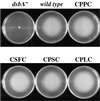Effect of sequences of the active-site dipeptides of DsbA and DsbC on in vivo folding of multidisulfide proteins in Escherichia coli
- PMID: 11208797
- PMCID: PMC94966
- DOI: 10.1128/JB.183.3.980-988.2001
Effect of sequences of the active-site dipeptides of DsbA and DsbC on in vivo folding of multidisulfide proteins in Escherichia coli
Abstract
We have examined the role of the active-site CXXC central dipeptides of DsbA and DsbC in disulfide bond formation and isomerization in the Escherichia coli periplasm. DsbA active-site mutants with a wide range of redox potentials were expressed either from the trc promoter on a multicopy plasmid or from the endogenous dsbA promoter by integration of the respective alleles into the bacterial chromosome. The dsbA alleles gave significant differences in the yield of active murine urokinase, a protein containing 12 disulfides, including some that significantly enhanced urokinase expression over that allowed by wild-type DsbA. No direct correlation between the in vitro redox potential of dsbA variants and the urokinase yield was observed. These results suggest that the active-site CXXC motif of DsbA can play an important role in determining the folding of multidisulfide proteins, in a way that is independent from DsbA's redox potential. However, under aerobic conditions, there was no significant difference among the DsbA mutants with respect to phenotypes depending on the oxidation of proteins with few disulfide bonds. The effect of active-site mutations in the CXXC motif of DsbC on disulfide isomerization in vivo was also examined. A library of DsbC expression plasmids with the active-site dipeptide randomized was screened for mutants that have increased disulfide isomerization activity. A number of DsbC mutants that showed enhanced expression of a variant of human tissue plasminogen activator as well as mouse urokinase were obtained. These DsbC mutants overwhelmingly contained an aromatic residue at the C-terminal position of the dipeptide, whereas the N-terminal residue was more diverse. Collectively, these data indicate that the active sites of the soluble thiol- disulfide oxidoreductases can be modulated to enhance disulfide isomerization and protein folding in the bacterial periplasmic space.
Figures



Similar articles
-
Engineered DsbC chimeras catalyze both protein oxidation and disulfide-bond isomerization in Escherichia coli: Reconciling two competing pathways.Proc Natl Acad Sci U S A. 2004 Jul 6;101(27):10018-23. doi: 10.1073/pnas.0403003101. Epub 2004 Jun 25. Proc Natl Acad Sci U S A. 2004. PMID: 15220477 Free PMC article.
-
DsbA and DsbC-catalyzed oxidative folding of proteins with complex disulfide bridge patterns in vitro and in vivo.J Mol Biol. 2003 Jan 17;325(3):495-513. doi: 10.1016/s0022-2836(02)01248-2. J Mol Biol. 2003. PMID: 12498799
-
In vitro and in vivo redox states of the Escherichia coli periplasmic oxidoreductases DsbA and DsbC.Biochemistry. 1997 Aug 19;36(33):10067-72. doi: 10.1021/bi9707739. Biochemistry. 1997. PMID: 9254601
-
[Escherichia coli disulfide-forming related proteins: structures, functions and their application in gene engineering for expressing heterologous proteins in Escherichia coli].Sheng Wu Gong Cheng Xue Bao. 2002 May;18(3):261-6. Sheng Wu Gong Cheng Xue Bao. 2002. PMID: 12192853 Review. Chinese.
-
Periplasmic chaperones used to enhance functional secretion of proteins in E. coli.Methods Mol Biol. 2011;705:211-24. doi: 10.1007/978-1-61737-967-3_12. Methods Mol Biol. 2011. PMID: 21125388 Review.
Cited by
-
Rv2969c, essential for optimal growth in Mycobacterium tuberculosis, is a DsbA-like enzyme that interacts with VKOR-derived peptides and has atypical features of DsbA-like disulfide oxidases.Acta Crystallogr D Biol Crystallogr. 2013 Oct;69(Pt 10):1981-94. doi: 10.1107/S0907444913017800. Epub 2013 Sep 20. Acta Crystallogr D Biol Crystallogr. 2013. PMID: 24100317 Free PMC article.
-
Engineered DsbC chimeras catalyze both protein oxidation and disulfide-bond isomerization in Escherichia coli: Reconciling two competing pathways.Proc Natl Acad Sci U S A. 2004 Jul 6;101(27):10018-23. doi: 10.1073/pnas.0403003101. Epub 2004 Jun 25. Proc Natl Acad Sci U S A. 2004. PMID: 15220477 Free PMC article.
-
Origin of anti-tumor activity of the cysteine-containing GO peptides and further optimization of their cytotoxic properties.Sci Rep. 2017 Jan 16;7:40217. doi: 10.1038/srep40217. Sci Rep. 2017. PMID: 28091523 Free PMC article.
-
Disulfide Bond Formation in the Periplasm of Escherichia coli.EcoSal Plus. 2019 Feb;8(2):10.1128/ecosalplus.ESP-0012-2018. doi: 10.1128/ecosalplus.ESP-0012-2018. EcoSal Plus. 2019. PMID: 30761987 Free PMC article. Review.
-
Disulfide bond isomerization in prokaryotes.Biochim Biophys Acta. 2008 Apr;1783(4):530-4. doi: 10.1016/j.bbamcr.2008.02.009. Epub 2008 Feb 23. Biochim Biophys Acta. 2008. PMID: 18342631 Free PMC article. Review.
References
-
- Bardwell J C, McGovern K, Beckwith J. Identification of a protein required for disulfide bond formation in vivo. Cell. 1991;67:581–589. - PubMed
-
- Belin D, Vassalli J D, Combepine C, Godeau F, Nagamine Y, Reich E, Kocher H P, Duvoisin R M. Cloning, nucleotide sequencing and expression of cDNAs encoding mouse urokinase-type plasminogen activator. Eur J Biochem. 1985;148:225–232. - PubMed
Publication types
MeSH terms
Substances
Grants and funding
LinkOut - more resources
Full Text Sources
Other Literature Sources
Molecular Biology Databases

